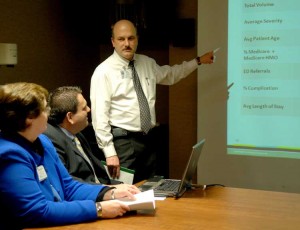 In this new JHC Blog, we’ll ask supply chain professionals about a problem they’ve encountered recently and the solution they used to overcome it. It could cover driving down costs, physician preference items, standardization, staff realignment — just about anything. Today’s Problem Solver — Brent Petty, corporate supply chain director at Wellmont Health System, Kingsport, Tenn.
In this new JHC Blog, we’ll ask supply chain professionals about a problem they’ve encountered recently and the solution they used to overcome it. It could cover driving down costs, physician preference items, standardization, staff realignment — just about anything. Today’s Problem Solver — Brent Petty, corporate supply chain director at Wellmont Health System, Kingsport, Tenn.
The problem: Product supply utilization. Why does one surgeon use $19,000 worth of materials for open heart surgery while another uses $23,000? Wellmont’s supply chain wanted to quantify the discrepancies to see if there could be cost savings involved without sacrificing patient safety or hindering the physician in any way.
The solution: Petty used data and heart-to-heart talks with the health system’s physicians to determine which physician preference items were worthwhile and which might not have to be used as much. When physicians have data on hand and other health system peers to compare their costs to, Petty has found that they’ve been able to find savings without pushback.
“We’re doing it based off of DRGs,” Petty says. “We take everybody that had a case that coded to that DRG during a particular timeframe, and we simply pull everything out and say, well, here’s Dr. A, here’s Dr. B, and everything we used on this DRG. We did it in bariatrics, open heart, OB/GYN, and others. It’s amazing the results we get. Even if the physicians aren’t partners, they’re at least friends at the hospital, and they look over and say “Why does Dr. A do this $2,000 cheaper than I do?”
In one particular discussion with a physician in bariatrics, Petty asked him why he spent $3,000 more a case than his partner. The doctor pointed out two reasons:
1) He tied sutures outside the body instead of inside. “Well, he had me on the suture,” Petty says. “I didn’t have any idea what the difference was tying it inside the body and outside the body. It never dawned on me that that could be two different ways of doing that.”
2) Peri-Strips. This item looks like a sterile piece of tape and is extremely strong. The bariatrics doctor used $1,800 worth on a particular case and Petty asked him of its advantages. [The doctor] said ‘if you’ll look, my return cases are less.’ They had less infection, therefore they don’t come back. If you spend $1,800 and not have an infection come back, then that may be worth it, because we can spend up to $20,000 on infection if the patient has to come back for treatment.”
Two things happened following the conversation. Petty ran the numbers on the physician’s partners and found they didn’t have any more “do-overs” than he did, so the infection rate was low across the board. However, over the next 90 days, Petty noticed that this physician’s use of Peri-strips diminished greatly. “I never said anything else to him about it. All I did was present him the data.”

Be the first to comment on "Problem Solver: Brent Petty"